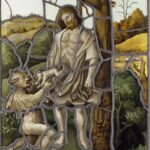Published December 15, 2012
The name “Tiffany” suggests conspicuous consumption: high-end jewelry; the diamonds that Marilyn Monroe claimed were a girl’s best friend (in a more innocent age, before Sandra Fluke and the HHS contraceptive mandate); Truman Capote, Holly Golightly, and the store that’s “the best place in the world, where nothing bad can take place.” Yet while one part of the Tiffany clan was creating jewelry for the Astors, the Vanderbilts, and other luminaries of the Gilded Age, Louis Comfort Tiffany, son of the firm’s founder, Charles Lewis Tiffany, was building an extensive business in church decoration and church furnishings.
Few now remember that the Gilded Age was a period of enormous congregational growth — and thus extensive church construction. Yet in the decade and a half between 1890 and 1906, some 4,000 churches were built in the rambunctiously commercial American republic. And a year before that boom began, Louis C. Tiffany established in the family firm an “ecclesiastical division” that eventually attracted the bulk of the Tiffany Studio’s commissions. Louis Tiffany was interested in the light that is reflected from a perfectly cut and beautifully set diamond, but he was just as interested, it seems, in the “light” that has never been more eloquently described than in the prologue to the Gospel of St. John: “In the beginning was the Word . . . In him was life, and the life was the light of men. . . . The true light that enlightens every man was coming into the world.” (John 1:1, 4, 9).
Christmastide visitors to New York City and locals who are interested in more than the lights of the Rockefeller Center Christmas tree have a chance to explore this aspect of the Tiffany legacy — and an often-underappreciated facet of American art and culture — in a fine exhibit currently mounted at the Museum of Biblical Art (MOBIA), which is housed in the American Bible Society building, just off Columbus Circle. ABS, which began in the early 19th century as an exclusively Protestant enterprise, is now a thoroughly ecumenical endeavor devoted to making the Word of God available throughout the world, in as many languages as possible. ABS also understands that the Bible has inspired some of the world’s greatest art: thus MOBIA and its current exhibit, “Louis C. Tiffany and the Art of Devotion.”
Handsomely laid out, the exhibit includes superb examples of Tiffany stained glass — a unique American variant on European stained-glass design and manufacture — as well as Tiffany mosaic work, Tiffany adaptations of Roman cosmatesque decoration (the use of small fragments of stone and glass in geometric decorative patterns), and Tiffany church furnishings (including candelabra, chandeliers, and altar pieces composed of silver-plated brass inlaid with enamel and glass). As befits an American designer, Louis C. Tiffany drew from a wide range of aesthetic sources, just as his native land was drawing immigrants from all over the world. Thus the exhibit displays Tiffany works that borrow from both Western and Eastern Christian aesthetic motifs as well as from the architecture of the Middle Ages, Italian Renaissance painting, and the Gothic revival style associated with such giants as Augustus Welby Northmore Pugin.
Yet while the various forms of the Tiffany Studio’s art all have something to be said for them, it is the stained glass that captures and holds the attention. It is not the stained glass of Chartres, but rather something quite different, and quite striking in its own way: an expression of that ancient art refracted through Pilgrim’s Progress, perhaps, rather than through The Golden Legend. However one describes the difference, though, a masterpiece like the exhibit’s focal point, the twelve-by-seven-foot window “The Righteous Shall Receive a Crown of Glory” (which was restored for the MOBIA show), demonstrates that the “light” of which St. John the Divine wrote inspired and shone through beautiful stained glass in Gilded Age America as well as in 13th-century France.
After enjoying the Tiffany exhibit, visitors to MOBIA would do well to spend some time in the space next door in the ABS headquarters, where MOBIA curator Dr. Liana Lupas has assembled a fascinating collection of English Bible translations from the same Gilded Age for which Louis Comfort Tiffany designed so many beautiful things. “More Precious than Fine Gold: The English Bible in the Gilded Age” tells its own, literary, tale of the late-19th- and early-20th-century Anglosphere’s passion for the Bible, which led to any number of attempts to bring Holy Writ closer to the people.
That this enterprise was as dicey then as it is now is nicely illustrated by one of my favorites in the collection Dr. Lupas has laid out: the Modern American Bible translation by Frank Schell Ballentine, which was published at the turn of the 20th century. Mr. Ballentine, it seems, was something of a Prohibitionist, and was not averse to what would be called today a “dynamic equivalence” approach to translating ancient languages, so long as it made his political points. Thus Ballentine rendered Luke 5:30 (where the Pharisees and scribes rebuke Jesus and his disciples for eating with what the Greek text clearly indicates are “tax-collectors and sinners”) as a rebuke against eating with “saloon-keepers and prostitutes” — a translation that probably pleased the Anti-Saloon League rather more than it did purists of biblical Greek.
The Lupas exhibit also showcases the biblical translation made by Julia Evelina Smith (1792-1886), the only woman ever to have translated the entire Bible by herself. Miss Smith was unhappy with the only great work of art ever produced by a committee (the King James Bible); to her mind, the Authorized Version did not hew closely enough to the original Hebrew and Greek, a putative fault she intended to repair in her own Bible. That her literal, word-for-word translation was not altogether successful is suggested by her rendering of Proverbs 15:17, an inadvertent anticipation of the cadences of the Star Wars character Yoda: “Good a ration of herbs and love there, above an ox of the stall and hatred with it.” (Which King James’s committeemen translated, “Better is a dinner of herbs where love is, than a stalled ox and hatred therewith.”)
“More Precious than Fine Gold” also contains several striking examples of the Gilded Age bookmaker’s art: Bibles of remarkable beauty, and reproductions of ancient Bibles and prayer books, which industrialized printing made available on a larger scale. Especially striking in the latter category is the reproduction of The Psalter or Psalms of David from the Bible of Archbishop Cranmer, published in 1902 in London.
In the foreword to his massive study, The Glory of the Lord: A Theological Aesthetics, the Swiss theologian Hans Urs von Balthasar wrote of beauty as a “main artery” of theology — Christianity’s disciplined reflection on the things of God, which put the things of this world in their true light. That aesthetic artery, Balthasar argued, had been severed by an excessive rationalism that reduced theology to a set of algorithms; I would add that the sheer ugliness of various modernisms in the plastic arts helped cut what was once a life-giving path to transcendence. Yet as Balthasar also argued, encountering the beautiful in this jaded and cynical age can open up the possibility of an encounter with the divine; for the beautiful, through which God discloses the things of God, is also “the manner in which God’s goodness . . . gives itself, and is expressed by God and understood by man as the truth . . .” Beauty carries us beyond relativism and skepticism, and opens
the door to the good and the true.
Louis C. Tiffany and the makers of beautiful Bibles and prayer books knew that. Visitors to “Louis C. Tiffany and the Art of Devotion” and “More Precious than Fine Gold” can know that, too.
George Weigel is Distinguished Senior Fellow of the Ethics and Public Policy Center in Washington, D.C. and holds EPPC’s William E. Simon Chair in Catholic Studies.









